See Full notes in PDF click here
Composite volcanoes
- Made up of alternating layers of lava and ash and containing sticky lava which doesn’t flow very far (e.g. Mt. Etna in Italy)
- Usually found at destructive plate boundaries
- Steep-sided and cone-shaped
Molten lava eventually cools to form new rocks. After more eruptions over time, the amount of rock builds up forming a cone-shaped volcano.
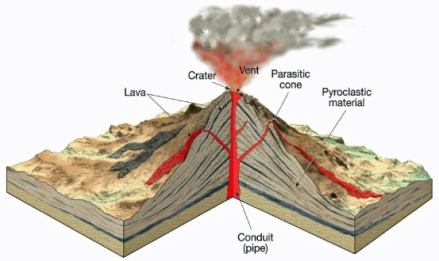
(Modified Pearson Prentice Hall, Inc., 2006 from oak.ucc.nau.edu/wittke/GLG101/5.pdf)
Different Types of Plate Boundaries
Constructive Plate Boundaries/Divergent Plate Margin
Divergent plate margin occurs when two continental plates move apart. As these plates move apart, it leaves cracks and fissures, lines of weakness, allowing magma to rise up from below the earth’s crust. Pressure builds up which then releases suddenly causing the magma to erupt onto the surface and cools as new land. Both earthquakes and volcanoes can result at these plate boundaries, the earthquakes are caused by the movement of magma through the crust. When this happens on land, a rift valley is formed.
E.g. Mid-Atlantic Ridge, East African Rift valley in Kenya
Oceanic plate uplifted and torn apart to produce a mid-oceanic ridge. New crust is generated between the diverging plates.
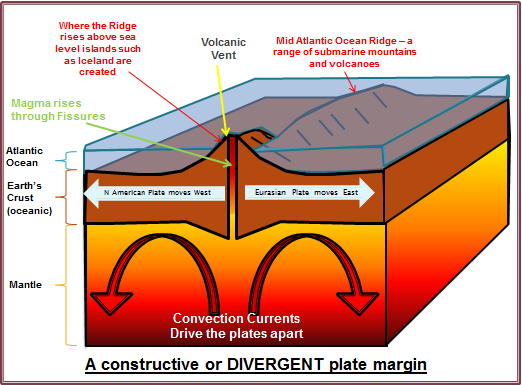
Destructive/Subduction Plate Boundaries
Two plates move or converge together and the oceanic plate (the denser plate) gets pushed under a continental plate (less dense) by convection currents deep within the Earth. The oceanic plate is subducted under the continental plate at a subduction zone, creating a deep ocean trench. The Oceanic crust sinks down into the mantle and as it descends friction, increasing pressure and heat from the mantle melt the plate. Some of the molten material work its way up through the continental crust through cracks in the crust. This is often some distance away from the margin where magma can eventually re-emerge at the surface to create a range of mountains. The movement of the plates grinding past one another can create earthquakes, when one plate eventually slips past the other releasing seismic energy. one oceanic plate(denser, get subducted under), one continental plate
E.g. Merapi (Java Indonesia), West coast of America, Philippines plate got pushed under the Eurasian plate
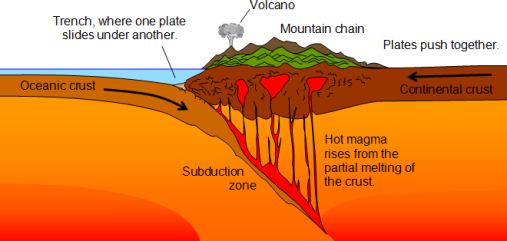
Collision
At these margins 2 plates of similar density are forced toward each other. The 2 plates crumple into one another and fold upwards into fold mountains. At these margins we get fold mountains (two continental plates collide) and earthquake activity, and a fantastic example of this is the Himalayan mountains. Here, the Indo-Australian plate is colliding with the Eurasian plate and has done so for millions of years.
Conservative Plate Margins
Volcanic eruptions do not happen and crust is not destroyed. Two plates either side past each other in opposite directions, or two plates slide past each other at different speeds. As they move past each other, energy is built as the plates grind on one another. When the energy is released it sends shock waves(earthquake) through the earth’s crust.
E.g. San Andreas fault in California (Pacific plate moving faster than North American plate)
Earthquake no volcano, two continental plates
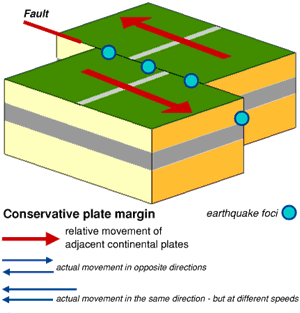
Recap:
Constructive margins:
- Constructive margins are formed by rising magma splitting up continental crust and forming new oceans
- The Eurasian Plate is separating slowly from the North American Plate. The mid-Atlantic ridge is a constructive margin sometimes visible above sea level, as in Iceland.
Conservative margins:
Where plates slide past each other or move in the same direction but at different speeds then:
- no crust is formed or destroyed, and volcanoes do not form
- great strain builds up along the junction, with sudden lurches along the fault
- earthquakes are frequent and often large
E.g. San Andreas fault
Destructive margins:
- Oceanic plates collide with continental plates
- Oceanic plate sinks beneath the continental plate
- Subduction creates a very deep ocean trench near the line of contact between the oceanic and continental plates
- Increased pressure and temperature
- long chains of volcanoes, known as volcanic arcs, are located above subducted plates (e.g. the indonesian islands)
New crust is made at constructive margins and old crust destroyed at destructive margins. Oceanic crust is created and destroyed. Continental crust is folded, crushed and compressed, but not destroyed.
What is the Pacific Ring of Fire and why are so many volcanoes and deep ocean trenches found here?
It is along plate boundaries where one plate is subducted under the other or plates are sliding past each other. The pressure and increased friction cause the rock sediments to rise up to the surface forming ocean trenches, volcanoes and earthquakes.
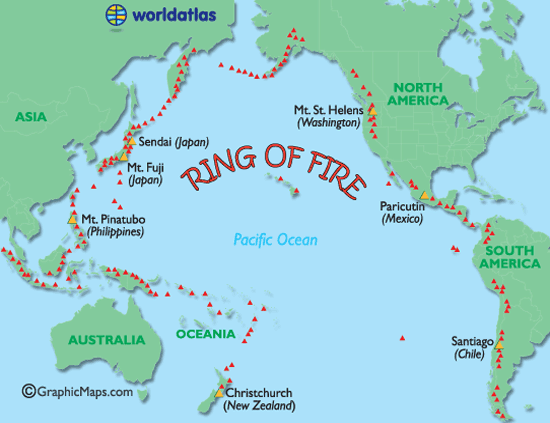
How do convection currents work and what is the link between convection currents and volcanoes?
definition of convection currents: high temperatures in the core caused by gradual radioactive decay create rising limbs of material in the mantle
These convection currents cool an spread out as they rise before sinking again – just like a lava lamp. Some of this rising an falling material moves in sheets, creating movements in the crust above it, which is pulled apart to form new crust. In other places it rises as columns, creating hotspots.
Heated rock in mantle rises as less dense; semi-molten rock spreads out, carrying the plate above with it; Magma cools and sinks back down to be reheated.
journey to the centre of the Earth: core, mantle, crust
What is a “hotspot”?
Hotspots are areas of rising plumes of magma in the asthenosphere which create volcanoes in the crust as it moves over them, leaving a long trail of island volcanoes. Crust is moving over a column of rising magma. (d.g. Hawaii)
The movement of tectonic plates is caused by the flow of alma beneath the earth’s crust’s surface. The movement may result in formation of valleys or eruptions of volcanoes.
Different Hazards and their Causes (Volcano)
Depends on:
- the size of the event
- the vulnerability of the population – poverty and high densities increase vulnerability
- the capacity of the population to cope – how prepared they are
Other secondary effects include:
- Food / water supply interrupted.
- Homelessness.
- Businesses forced to close.
- Cost of insurance claims.
- Unemployment.
- Long-term issues with the tourism industry.
Impact of earthquakes:
Primary impacts – the immediate effect of an earthquake on property and people. For earthquakes this is the people killed as a result of the shaking and property destruction.
Secondary impacts – the impact on property and people of an event after it has finished. Lack of shelter and basic supplies, as well as fires, are frequent secondary effects.
Living with volcanoes
Volcanoes kill far more people with gas emissions and ash than they do with lava.
Why people still live in danger zones
- some people think that disasters only affect other people and will never harm them – they ignore the dangers and assume they will be OK (lack of awareness of risk)
- some people come from families who have lived in danger areas for many many years – long before they knew that they were hazard zones – and they don’t want to break family ties by moving away (cultural links)
- some people think that scientists will be able to predict any seismic activity long enough in advance for the area to be evacuated – so they feel safe to live there
- some people simply may not be able to afford to move anywhere else (Poverty)
- some of the settlements in danger zones eg. Mexico City, San Francisco, Los Angeles, have grown into enormous megacities and there just isn’t space to rebuild them elsewhere away from danger
Approaches to living in danger areas
There are three main approaches – the fatalistic approach, the acceptance approach and the approach
- The fatalistic approach – If it happens, it happens – it’s all part of living in this area
- The acceptance approach – hazards are a part of everyday life here are we have learned to live with them – the benefits of living here outweigh the disadvantages
- The adaptation approach – events can be predicted and warnings given – this makes it safe to live here
Primary and secondary impacts of Mt. Merapi
- Gas emissions, earth tremors and ‘bulging’ of a volcano’s flanks can be measured and used to predict eruptions
- Tsunami warning sirens can be used to evacuate people from coast before tsunami waves strike.
Reducing the impact by mitigation such as hazard resistant buildings, disaster kits and land use planning. (Earthquake)
Building designs:
- Ground foundations – steel reinforced concrete slab foundation
- Balanced distribution of walls
- Large number of walls
- Structural Integrity of House – not old structure/rotten or eaten by termites
- Cross-bracing (to prevent floors from collapsing), shear wall, shear core, most, base isolator(absorbs pressure from the earthquakes)
Cool stuff
LikeLiked by 1 person
Hola rodri
LikeLike
you should include case studies but anx twas helpful
LikeLiked by 1 person